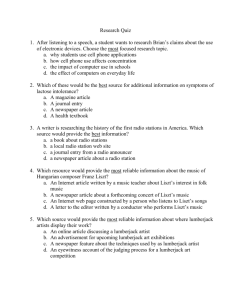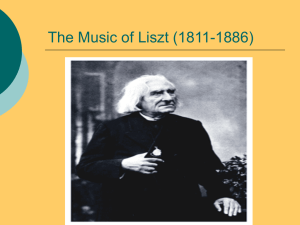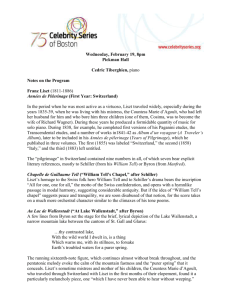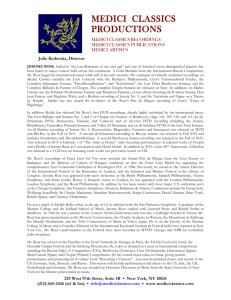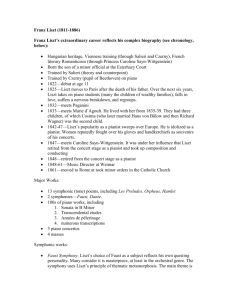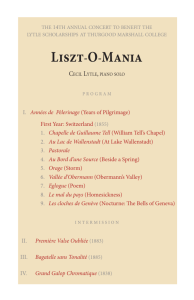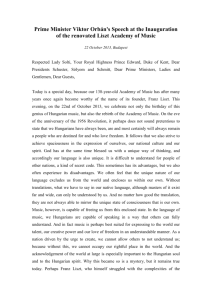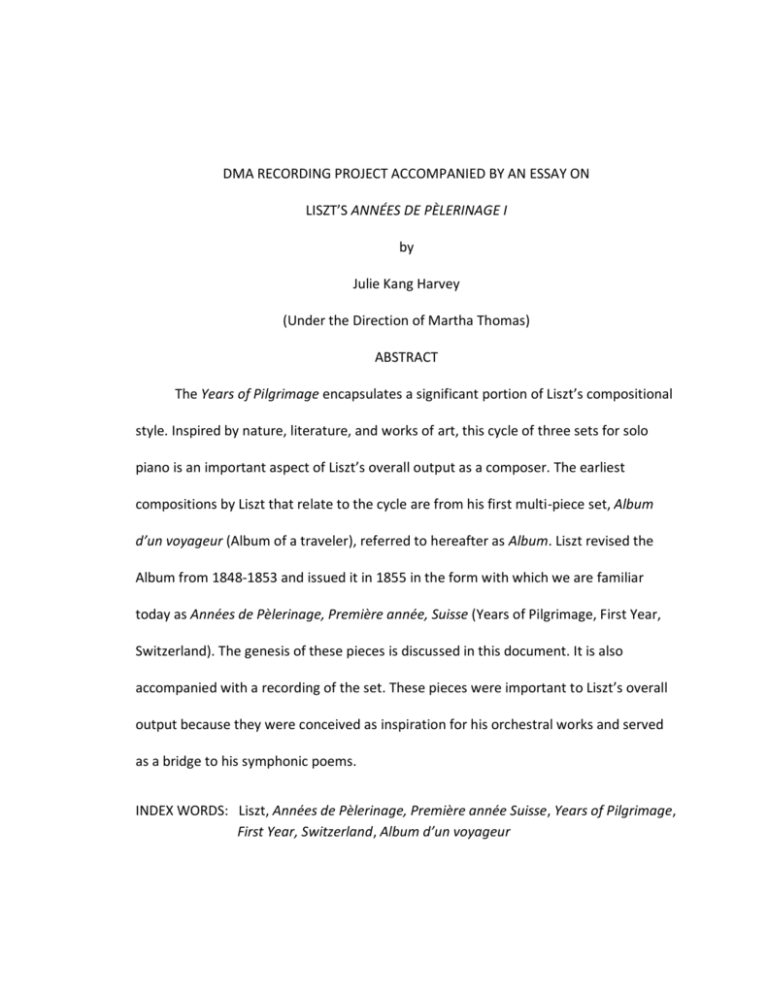
DMA RECORDING PROJECT ACCOMPANIED BY AN ESSAY ON
LISZT’S ANNÉES DE PÈLERINAGE I
by
Julie Kang Harvey
(Under the Direction of Martha Thomas)
ABSTRACT
The Years of Pilgrimage encapsulates a significant portion of Liszt’s compositional
style. Inspired by nature, literature, and works of art, this cycle of three sets for solo
piano is an important aspect of Liszt’s overall output as a composer. The earliest
compositions by Liszt that relate to the cycle are from his first multi-piece set, Album
d’un voyageur (Album of a traveler), referred to hereafter as Album. Liszt revised the
Album from 1848-1853 and issued it in 1855 in the form with which we are familiar
today as Années de Pèlerinage, Première année, Suisse (Years of Pilgrimage, First Year,
Switzerland). The genesis of these pieces is discussed in this document. It is also
accompanied with a recording of the set. These pieces were important to Liszt’s overall
output because they were conceived as inspiration for his orchestral works and served
as a bridge to his symphonic poems.
INDEX WORDS: Liszt, Années de Pèlerinage, Première année Suisse, Years of Pilgrimage,
First Year, Switzerland, Album d’un voyageur
A DMA RECORDING PROJECT ACCOMPANIED BY AN ESSAY ON
LISZT’S ANNÉES DE PÈLERINAGE I
by
JULIE KANG HARVEY
B.M., University of Toronto, 1997
M.M., Georgia State University, 2008
A Document Submitted to the Graduate Faculty of The University of Georgia in Partial
Fulfillment of the Requirements for the Degree
DOCTOR OF MUSICAL ARTS
ATHENS, GEORGIA
2013
© 2013
Julie Kang Harvey
All Rights Reserved
A DMA RECORDING PROJECT ACCOMPANIED BY AN ESSAY ON
LISZT’S ANNÉES DE PÈLERINAGE I
by
JULIE KANG HARVEY
Major Professor:
Martha Thomas
Committee:
Richard Zimdars
Stephen Valdez
Electronic Version Approved:
Maureen Grasso
Dean of the Graduate School
The University of Georgia
August 2013
iii
DEDICATION
To my mother, Jong Hee Kang
June 30, 1937- October 18, 2012
iv
TABLE OF CONTENTS
Page
LIST OF FIGURES ............................................................................................................. vi
LIST OF EPIGRAPHS ........................................................................................................ vii
INTRODUCTION ...............................................................................................................1
HISTORY OF ANNÉES DE PÈLERINAGE I ............................................................................1
"Chapelle de Guillaume Tell" ......................................................................................12
"Au lac de Wallenstadt" .............................................................................................13
"Pastorale" .................................................................................................................14
"Au bord d’une source" ..............................................................................................15
"Orage" ......................................................................................................................15
"Eglogue" ...................................................................................................................16
"Vallée d’Obermann" .................................................................................................16
"Le mal du Pays" ........................................................................................................20
"Les cloches de Genève" ............................................................................................21
CONCLUSION .................................................................................................................22
BIBLIOGRAPHY...............................................................................................................23
v
LIST OF FIGURES
Page
Figure 1: Franz Liszt, “Au lac de Wallenstadt” (from the Years of Pilgrimage),
mm.1-2 .................................................................................................................. 14
Figure 2: Franz Liszt, “Vallée d’Obermann” (from the Album), mm.207-209 ................. 17
Figure 3: Franz Liszt, “Vallée d’Obermann” (from the Years of Pilgrimage),
mm.214-217 .......................................................................................................... 17
Figure 4: Franz Liszt, “Vallée d’Obermann” (from the Years of Pilgrimage),
mm.75, 76 ............................................................................................................. 19
Figure 5: Franz Liszt, “Vallée d’Obermann” (from the Years of Pilgrimage),
mm.119-121 .......................................................................................................... 20
vi
LIST OF EPIGRAPHS
Page
Epigraph 1 .......................................................................................................................7
Epigraph 2 .......................................................................................................................7
Epigraph 3 .......................................................................................................................7
Epigraph 4 .......................................................................................................................7
Epigraph 5 .......................................................................................................................8
Epigraph 6 .......................................................................................................................8
Epigraph 7 .......................................................................................................................8
Epigraph 8 .......................................................................................................................9
Epigraph 9 .....................................................................................................................11
vii
INTRODUCTION
The Years of Pilgrimage encapsulates a significant portion of Liszt’s
compositional style. Inspired by nature, literature, and works of art, this cycle of three
sets for solo piano is an important aspect of Liszt’s overall output as a composer. The
genesis of the pieces in the Premiere Année of Liszt’s Années de Pèlerinage (First Year of
the Years of Pilgrimage) is discussed in this document. Throughout this paper the author
will refer to this as Book One from the Years of Pilgrimage. It is also accompanied with a
recording of the set. In addition to learning Book One of this collection, I am also in the
process of learning Book Two. My ultimate goal is to learn Book Three in the years to
come. This cyclic approach will enable me to see the evolution of Liszt’s style in a
comprehensive manner.
The initial inspiration for this project occurred at the American Liszt Society
Bicentennial Festival hosted by the University of Georgia in February 2011. The
multitude of performances and lectures first sparked my interest. Specifically, the
performance of “Après une Lecture du Dante” (“After a Reading of Dante”), commonly
referred to as the “Dante Sonata” (from Book Two of the Years of Pilgrimage), inspired
me to pursue learning these pieces.
HISTORY OF ANNÉES DE PÈLERINAGE I
The earliest compositions by Liszt that relate to the cycle are from his first multipiece set, Album d’un voyageur (Album of a traveler), referred to hereafter as Album.
1
Most of the pieces included in the Album were written in 1835-1836. The entire cycle
was published in 1842. 1
The Album contains nineteen pieces published in three books: Impressions et
Poésies, Fleurs mélodiques des Alpes, and Paraphrases. With its variety of works, pieces
with a folk-like quality, improvisations, and variations on themes, the Album represents
a comprehensive overview of Liszt’s many interests at the time. The contents of the
entire collection are listed below.
I.
Impressions et Poésies (Impressions and Poems)
1. “Lyon”
2a. “Au lac de Wallenstadt” (“The Lake of Wallenstadt”)
2b. “Au bord d’une source” (“On the edge of a spring”)
3. "Les cloches de Genève” (“The bells of Geneva”)
4. “Vallée d’Obermann” (“Obermann Valley”)
5. “Chapelle de Guillaume Tell” (“Chapel of William Tell”)
6. “Psaume” (“Psalm”)
II.
Fleurs mélodiques des Alpes (Melodic flowers of the Alps) (without titles)
Nos. 7a, 7b, 7c, 8a, 8b, 8c, 9a, 9b, 9c.
III.
Paraphrases
10. "Ranz de vaches de Huber Improvisata" (Swiss Alpine melody)
11. "Un soir dans les montagnes (de Knop) Nocturne Pastoral" (“A night
in the mountains”)
12. “Ranz de chèvres”2 (Swiss goat herd song)
Impressions et Poésies contains a wide variety of original pieces that evolved
throughout Liszt’s travels. The musical material in Fleurs mélodiques des Alpes has a
folk-like character representative of the areas in which he traveled. The final book,
1
Humphrey Searle, The Music of Liszt (New York: Dover Publications, 1966), 23.
Franz Liszt, Ferenc Liszt-Piano Works: Album D’un Voyageur I, III, ed. Adrienne Kaczmarczyk and Imre
Mező (Budapest: Editio Musica, 1970), 6.
2
2
Paraphrases, was published in 1836 as Trois airs Suisse.3 It includes lengthy
improvisations and variations based on themes by Ferdinand Huber (1791-1863) and
Ernest Knop (1786-1859). Ferdinand Huber, a Swiss composer, was well known for his
Swiss-Alpine music. Ernest Knop was a publisher and composer living in Basel,
Switzerland. He befriended Liszt and, in addition to taking him on excursions to the city,
Knop introduced Liszt to his popular publications and volumes of Swiss songs with piano
and guitar accompaniment. Liszt had already come in contact with Swiss-Alpine music,
but it was in Knop’s publications that Liszt discovered those simple arrangements that
became the starting points of the three piano pieces contained in Paraphrases.4 As
indicated by the title, the middle piece in this set was based on a composition by Knop.
With the exception of “Lyon” and “Psaume”, Liszt revised all the pieces
contained in Impressions et Poésies, Book One of the Album, for placement in Book One
of the Years of Pilgrimage. From the second book of the Album, Fleurs mélodiques des
Alpes, Liszt heavily revised 7b and 7c for inclusion in Book One of the Years of Pilgrimage
and titled them “Le mal du pays” and “Pastorale”. “Eglogue” (1836) and “Orage” (1855),
the only completely new pieces in the Swiss cycle, had no previous affiliation with the
Album. “Eglogue” is an arrangement of a ranz de chèvres (Swiss goat herd song) and was
published separately in 1836 before being included in Book One. “Orage” was published
in 1855.5
3
Ben Arnold, The Liszt Companion (London: Greenwood Press, 2002), 79.
Liszt, Album D’un Voyageur, 6.
5
Arnold, The Liszt Companion, 82.
4
3
An examination of the Album is essential for understanding the genesis of the
pieces belonging to Book One of the Years of Pilgrimage. We are able to see where
these pieces originated, how they evolved, and what function they served in Liszt’s
overall output as a composer. Liszt revised the Album from 1848-1853 and issued it in
1855 in the form with which we are familiar today as Années de Pèlerinage, Première
année, Suisse (Years of Pilgrimage, First Year, Switzerland). The contents of this set are
listed below. The accompanying dates below are the original dates of composition of the
selections in Book One.
1.
2.
3.
4.
5.
6.
7.
8.
9.
“Chapelle de Guillaume Tell.” 1835-36. (“Chapel of William Tell”)
“Au lac de Wallenstadt.” 1835-36. (“The Lake of Wallenstadt”)
“Pastorale.” 1835-36. (“Pastoral”)
“Au bord d’une source.” 1835-36. (“On the edge of a source”)
“Orage.” 1854. (“Storm”)
"Vallée d’Obermann.” 1835-36. (“Obermann Valley”)
“Eglogue.” 1836. (“Bucolic”)
"Le mal du pays." 1835-36. ("Homesickness")
“Les cloches de Genève.” 1835-36.6 (“The bells of Geneva”)
Liszt regarded this revision as being synonymous with the withdrawal from
circulation of the earlier Album. In order to prevent the performance of the work, he
bought back the publication rights of the Album from the work’s publisher, Haslinger, in
1850.7 Liszt’s process of revision appeared to have been endless. The following
statement, illustrates Liszt’s dissatisfaction with his revision many years later. Liszt
comments, “in the first year there are pieces that still please me today. But there are
6
Andrew Fowler, “Franz Liszt’s ‘Années de Pèlerinage’ as Megacycle,” Journal of the American Liszt
Society 40 (June 1996): 113.
7
Franz Liszt, Ferenc Liszt-Piano Works: Années de Pèlerinage I, ed. Imre Mező and Imre Sulyok (Budapest:
Editio Musica, 1976), 10.
4
many repetitions that I would not write today.”8 This excerpt illustrates how Liszt
continued to be dissatisfied and critical of his compositions even long after the cycle was
published. An invaluable source for Liszt scholarship, the aforementioned diary provides
a comprehensive insight into the Lisztian teaching method, and contains valuable
instructions from Liszt on interpretation and piano playing. 9
Most of the pieces that were eventually included in Book One of the Years of
Pilgrimage were conceived during Liszt’s travels in Switzerland from 1835-1837. He was
accompanied by his lover, Marie d’Agoult, who came from a wealthy, powerful German
family, was unhappily married and the mother of two children when she first met Liszt.
This relationship initiated Liszt’s departure from Paris for years of travel with Marie
d’Agoult first to Switzerland, then to Italy, Vienna and Hungary. 10 Liszt drew much of his
inspiration from the Swiss landscape and its rich folk music tradition. Alan Walker, in his
work Franz Liszt: The Virtuoso Years, 1811-1847, says, “these pieces, distinctly
impressionistic in character, are filled with the sights and sounds of the Swiss
countryside, whose natural beauty enchanted him.”11 The title, Years of Pilgrimage,
refers to Goethe’s famous novel of self-realization, Wilhelm Meisters Lehrjahre (Wilhelm
Meister’s Apprenticeship). 12 Liszt wrote the following introduction to the collection:
Having recently visited many new countries, different landscapes, places
consecrated by history and poetry, having felt that the varying species of
nature and the scenes associated with them did not pass before my eyes as
idle images but stirred profound emotions in my soul, that they established
8
William Jerger and Richard Zimdars, eds. The Piano Master Classes of Franz Liszt 1884-1886: Diary Notes
of August Gőllerich (Bloomington: Indiana University Press, 1996), 155.
9
Ibid., 8.
10
Ibid., 192.
11
Alan Walker, Franz Liszt: The Virtuoso Years, 1811-1847 (New York: Cornell University Press, 2004), 217.
12
Liszt, Album D’un Voyageur, 10.
5
between them and myself a vague but direct relationship, an undefined but
real rapport, an inexplicable but certain communication, I have sought to
convey in music some of my most powerful sensations and most vivid
perceptions.13
Leaders of the Romantic Movement had an enormous influence on Liszt. He met
with and befriended many of them in Paris. Among them were writers Victor Hugo,
Alphonse de Lamartine, Alfred de Vigny, Alfred de Musset, George Sand, Heinrich Heine
and many others. Paris became his mental homeland and French became his favorite
language.14 Liszt studied the writings of ancient and contemporary French philosophers
and became obsessed with French society. He even adopted their new aesthetic
principles. Like the French, he also idolized Dante Alighieri, William Shakespeare, JeanJacques Rousseau, Count Claude Henri de Saint-Simon, and Lord Byron. These figures
had a significant impact on his life and artistic development.
In Book One of the Years of Pilgrimage, Liszt was inspired by Georges Sand’s
Lettres d’un voyageur (Letters of a traveler), Lord Byron’s Childe Harold’s Pilgrimage,
Friedrich Schiller’s Der Flüchtling (The Fugitive) and Étienne Sénancour’s Obermann.15 To
be a wanderer and pilgrim, not belonging anywhere and looking for a place to belong
was a central concept of Romanticism. The theme of being a wanderer must have
contributed to Liszt’s frame of mind and seemed to be a central theme to this collection.
Every piece in Book One of Years of Pilgrimage is accompanied with a literary
motto or preface with the exception of “Pastorale”. “Les cloches de Genève”, appears
with a motto only in the Album version. These prefaces range from short fragments by
13
Ibid.
Ibid.
15
Alfred Brendel, On Music: His Collected Essays (Chicago: Chicago Review Press, 2007), 256.
14
6
Byron or Schiller (numbers 2, 4, 5, 7) to the extensive writing excerpts of Sénancour in
“Vallée d’Obermann” and “Le mal du pays.” These textual references below, taken from
the Musica Budapest edition, provide a descriptive context that prepares the listener for
the music.16
Epigraph 1
"La Chapelle de Guillaume Tell"
“One for All-All for One”17
(Schiller, Wilhelm Tell)
Epigraph 2
“Au lac de Wallenstadt”
“Thy contrasted lake, with the wild world I dwell in is a thing which warns me,
with its stillness, to forsake earth’s troubled waters for a purer spring.”18
(Byron, Childe Harold’s Pilgrimage)
Epigraph 3
“Au bord d’une source”
“In the murmuring coolness begins the play of young nature.” 19
(Schiller, Der Flüchtling)
Epigraph 4
“Orage”
“But where of ye, O tempests, is the goal?
Are ye like those within the human breast?
Or do ye find, at length, like eagles, some high nest?”20
(Byron, Childe Harold’s Pilgrimage)
16
Arnold, The Liszt Companion, 78.
Liszt, Années de Pèlerinage I, 2.
18
Ibid., 8.
19
Ibid., 15.
20
Ibid., 22.
17
7
Epigraph 5
“Vallée d’Obermann”
“What would I? What am I? What must I ask of Nature?
Every cause is invisible, every aim deceptive; every form changes, all continuance
comes to an end. I feel, I exist simply to be the prey of untamable desires, to be
besotted by the spell of a fantastic world, and to stand aghast at its dazzling falsity.
Vast consciousness of a nature everywhere, overwhelming and impenetrable,
Universal passion, indifference, advanced wisdom, voluptuous abandon,
all the desires and all the profound torments, that a human heart can hold,
I have felt them all, suffered them all in this memorable night,
I have made a sinister step towards the age of Enfeeblement;
I have eaten up ten years of my life.” 21
(Sénancour, Obermann)
Epigraph 6
“Vallée d’Obermann”
“Could I embody and unbosom now that which is most within me,
Could I wreak my thoughts upon expression, and thus throw soul, heart, mind,
Passions, feeling, strong or weak.
All that I would have sought, and all I seek, bear, know, feel, and yet breatheInto one word, and that one word were Lightning, I would speak;
But as it is, I live and die unheard, with a most voiceless thought,
Sheathing it as a sword.” 22
(Byron, Childe Harold’s Pilgrimage)
Epigraph 7
“Eglogue”
“The morn is up again, the dewy morn,
With breath all incense, and with cheek all bloom,
Laughing the clouds away with playful scorn,
And living as if earth contain’d no tomb.”23
(Byron, Childe Harold’s Pilgrimage)
21
Étienne Senancour, Obermann (Baltimore: Noumena Press, 2010), 256.
Liszt, Années de Pèlerinage I, 30.
23
Ibid., 46.
22
8
Epigraph 8
“Le mal du pays”
“The sensational captivates crude and lively imaginations, but thoughtful minds of
genuine susceptibility are satisfied with the purely romantic. Nature abounds in
romantic effects in out-of-the-way places, but in time-worn regions they are spoiled by
incessant cultivation, especially in plains which have readily submitted in very part to
the sway of man.
Romantic effects are the accents of a tongue which is not intelligible to all men, and is
becoming in some places quite a dead language. We soon cease to understand them
when we no longer live in their midst, and yet this romantic harmony is the only thing
which can keep fresh in our hearts the colors of youth and the bloom of life. The society
man is no longer conscious of these effects; they are too remote from his mode of life,
and he ends by saying,
“What use are they?” His constitution is burnt out, as it were, by the parching heat of
a slow and constant poison; he is old when he should be in full vigor, and the springs of
life are relaxed within him though he still wears the husk of a man.
But you, whom the man in the street considers his equals, because you live simply
and make no display of cleverness with your gifts, or just because your life is open to
him and he sees that you eat and sleep as he does- you, men of primitive tastes,
dispersed here and there to preserve the flavor of natural things in this age of vanity,
you recognize each other, you hold converse in a tongue the crowd knows nothing of,
when the October sun shines through the mist above the yellowing woods; when
beneath the setting moon a tumbling streamlet drops into a wood-grit meadow; when
in a cloudless summer dawn, a woman’s voice is heard not far away singing amid the
walls and roofs of some great town.
Imagine a vast though bounded sheet of clear transparent water, oblong in shape,
and sweeping in a wide curve towards the western horizon. Lofty peaks and glorious
ranges enclose it on three sides. You are seated on the mountain side that slopes down
to the northern beach on which the waves are breaking. Behind you sheer precipices lift
their heads to the clouds; the dreary polar wind has never breathed on this happy
shore. On your left the mountains open out and a quiet valley stretches far into their
depths; a mountain stream comes tumbling downward from the snow-clad heights that
bound it. Then when the morning sun appears between the icy peaks above the mists,
when mountain voices betray the whereabouts of chalets above the meadows still in
shadow, that is the awakening of an unspoiled world, and the proof of what a destiny
we have ignored.
Or take the hour of twilight, the time of rest and soul-expanding pensiveness. The
valley is hazy and darkening fast. Southward night has fallen on the lake; the rocks
beyond it form a belt of gloom below the icy dome that crowns them, where the light of
day still lingers on the frozen snow. Its last gleams gild the countless chestnuts above
the desolate crags, they shoot in long rays between the tall stems of the mountain
pines, they glow on the Alps, they kindle the snows, they flame the air and the unruffled
lake, radiant with light from the skies reflected in its breast, becomes infinite like them,
9
and purer, more ethereal, more lovely even than they. Its calm is a marvel, its clearness
a mystery; the aerial splendor it mirrors seems ensphered in its depths, and under those
mountains, cut off from the earth as though hung in air, you see at your feet the vaulted
heavens and the great round world. It is a time of enchantment and ecstasy. Sky and
mountains and the solid ground beneath you seem adrift in space; the level lake and the
horizon are dissolved. Your ideas are transformed, your sensations wholly new, common
lift is left behind, and when the disk has settled on this sheet of water, when the eye can
no longer distinguish objects and distance, when the evening breeze ripples the surface,
then the western extremity of the lake alone gleams with pale light, but the part
encircled by mountains is all one gulf of thickest gloom. Then from the depths of
shadow and silence a thousand feet below there reaches your ear the ceaseless wash of
the waves, as billow follows billow without intermission to surge over the sand with
measured pulse, to be shattered by the rocks or to break on the short, while its peals
reverberate with a long-drawn murmur in the invisible abyss.
It is in sounds that Nature has vested the most forceful expression of the romantic
element; it is through the sense of hearing above all that one can bring to mind
extraordinary places and things with the fewest touches and in the most effective way.
The associations stirred by scents are swift and vast, but vague; those of sight have
more interest for the mind than the heart; seeing evokes wonder; hearing, emotion.
The voice of a loved one is sweeter than her features; sublime scenery makes a
deeper and more lasting impression by the sounds that haunt it than by its forms. I have
seen no picture of the Alps which recalled them to me so vividly as a genuine Alpine
melody.
The “Ranz des Vaches” does more than awaken reminiscences; it paints a picture. I
know that Rousseau has stated the opposite, but I think he is wrong. It is not mere
imagination; a case in point is that of two people looking through the plated of the
harpsichord of colors independently, and remarking at the sight of the Grimsel, “That is
the place to hear the ‘Ranz des Vaches.’” If it is performed with sympathy rather than
art, if the player’s soul is in it, the first notes transport us to the high valleys on the
fringe of the bare, reddish gray rocks, beneath the sun that burns in a cool sky. We rest
on some rounded grass-grown knoll, steeped in the unhasting calm of things and in the
grandeur of the scene; we see the plodding step of the cows and the measured swing of
their big bells, close under the cloud belt, on the gently sloping breast between the solid
granite crags, and the granite screes of the snow-streaked ghylls. The wind moans
desolately through the distant larches, and one can distinguish the hum of the unseen
torrent deep sunk in the gorge it has carved out in the course of ages. To these lonely
sounds succeed the hurried doleful tones of the cowherds’ song, the pastoral expression
of sober gladness and mountain exhilaration. The songs come to an end; the man
disappears in the distance; the cow-bells have passed the larches; and now one only
hears the rattle of falling stones and the intermittent crash of trees borne down by the
torrent to the valley below. These Alpine sounds swell out and fail on the wind; and in
the intervals of silence, all seems chill, motionless, and dead. It is the domain of the
phlegmatic man. He sets out from his low and ample roof, secured with heavy stones
against the gales, and whether the wind rages or the thunder rolls beneath his feet is all
10
one to him. He trudges off to where his cows should be, and there they are; he calls
them and they gather up and take their turns; then back he goes with the same steady
pace, carrying milk for the plains he will never see. The cows stand chewing the cud;
nothing stirs, not a soul is visible. The air is chilly; the wind drops as twilight falls; and
nothing is left but the glimmer of perpetual snows, and the plunge of torrents whose
lonely hum comes up from below, and seems to emphasize unbroken silence of the
towering peaks, the glaciers, and the night.”24
(Sénancour, Obermann)
Epigraph 9
"Les cloches de Genève"
“I live not in myself, but I become portion of that around me.” 25
(Byron, Childe Harold’s Pilgrimage: Preface omitted in Book One)
These nine works that create this collection could be summarized as follows. The
set begins with a triumphant opening (1), and proceeds to more of a pastoral mood (24). We are then led into storm and unrest (5-6) before returning to a more pastoral
environment (7-8). The set ends with the symbolic ringing of the bells of Geneva.26
The revised pieces in Book One of the Years of Pilgrimage differ from the original
versions. However, the degree of alteration ranges from small adjustments to massive
re-workings and deletions.27 These differences are discussed later in this document.
In On Music: His Collected Essays, Alfred Brendel states that Book One of the
Years of Pilgrimage “deals with nature in a two-fold sense: as nature around us, and as
the nature within.”28 In “Lyon”, from the Album, Liszt was moved by the plight of the
starving workers and their families. The silk weavers of Lyon had been on strike for
months and had clashed with the police. The motto found at the beginning of the work,
24
Senancour, Obermann, 129.
Liszt, Album d’un Voyageur I, 30.
26
Arnold, The Liszt Companion, 82.
27
Ibid.
28
Brendel, On Music, 255.
25
11
“vivre en travaillant ou mourir en combattant” (live laboring or die fighting), was
inspired by the silk weavers of Lyon who rebelled against their appalling working
conditions in 1831 and again in 1834 and were now in a desperate situation. 29 After the
uprisings, Abbot Félicité de Lamennais defended several of the workers in the court
proceedings initiated against them. The final version of the work came to fruition in
1837-1838 following Liszt’s visit to Lyon. In August 1837 he gave a charity concert to aid
the local laborers. The March theme at m. 34 is also found in Liszt’s earlier sketches
dated June 16, 1833.30
“Chapelle de Guillaume Tell”
Similarly, Liszt’s support of the revolutionary movements of the time are
evidenced in “Chapelle de Guillaume Tell” which was inspired by Schiller’s play of the
Swiss struggle for liberation and the pursuit of freedom. In this piece Liszt creates
realistic alphorn echo effects which conjure up the legend of the Swiss national hero.
According to the myth, Tell, who refuses to show deference to the Austrian invaders, is
forced to shoot an apple off his son’s head with a bow. He succeeds but is sent to prison
nonetheless. He manages to escape, kills his captor, and sparks a rebellion that leads to
the formation of the Swiss Confederation. The legend evidently appealed to Liszt. In a
display of his belief in democratic ideals he inscribed at the top of the score the words of
Schiller, “Einer für Alle- Alle für Einen” (One for all, all for one), which became and
remains Switzerland’s unofficial motto. From the majestic chords of the opening to the
29
30
Ibid.
Arnold, The Liszt Companion, 82.
12
stormy tremolo passages with horn calls, “Chapelle de Guillaume Tell” evokes a rousing
call to arms. The recitative section quotes a Swiss Alpine horn melody. 31 Comparing
pieces in their original versions from the Album and the revised versions in Years of
Pilgrimage, the most dramatic differences occur in the “Chapelle de Guillaume Tell.” The
only element in common with the two versions is the theme that starts in measure four
of the revision. The original version in the Album is much more virtuosic and technically
demanding compared to the thinned out texture of the revision.
“Au lac de Wallenstadt”
“Au lac de Wallenstadt”, an elegant piece reminiscent of the style of
Mendelssohn, has minor changes compared to the original version. Originally, this
composition was joined with “Au bord d’une source”. They share the same subject
matter and key of A-flat major. However, these two works were completely separated in
the Years of Pilgrimage and are two distinct compositions. “Au lac de Wallenstadt” is
prefaced with a quotation from Byron’s Childe Harold’s Pilgrimage. The piece consists of
an undulating accompanimental figure (Figure 1) creating a musical depiction of gentle
ripples in the water.
31
Ibid.
13
Figure 1: Franz Liszt, “Au lac de Wallenstadt ̋, mm.1-2. 32
This figure, though not technically difficult to execute, poses some challenges in
producing a smooth sound that is free of nuance. This piece was inspired by the
beautiful shores of the lake of Wallenstadt, a place where Liszt and his lover, Marie
d’Agoult, shared many happy memories.33
“Pastorale”
“Pastorale” is a somewhat shortened version of 7c from the Album and, unlike
the other pieces, has no literary preface. The original version is in the key of G-major
and is more than twice as long as the revision. It contains a starkly contrasting middle
section that Liszt omits completely in the new version. The revised version, in the new
key of E-major, closes with the B theme rather than with the return of the A theme, as it
does in the original. The music, folk-like in character, elicited this response from
Humphrey Searle: “it has all the freshness and spontaneity of Bartok’s folk song
arrangements and Hungarian folk songs.”34
32
Liszt, Années de Pèlerinage I, 8.
Walker, Franz Liszt, 217.
34
Searle, The Music of Liszt, 30.
33
14
“Au bord d’une source”
The original version of “Au bord d’une source” (1835) is much more difficult and
virtuosic than the revised version which has a light and delicate quality. Liszt achieves
this by replacing the long arpeggiated passages of the original with simple broken
chords in the left hand. By confining the range of notes to a smaller area of the piano,
Liszt provides the performer with efficiency of movement and a more manageable
setting. The pianistic figures evoke the imagery of a murmuring spring flowing lightly
over rocks. The piece also shares the same compound meter as “Pastorale”. Also, in the
revision, Liszt rearranged the redistribution of the hands in order to provide a more
comfortable and pianistic approach for the performer.
“Orage”
As mentioned earlier, “Orage” and “Eglogue” are the only new pieces added to
the cycle. In contrast to the other pieces in the collection that display a more tranquil
nature, “Orage”, set in the dark key of C-minor, represents a wild mountain storm. The
music is technically challenging and violently rich with its octave passages, arpeggios
and many tremolos. Its principal theme, marked Presto Furioso, has a wild majesty
about it as it descends through the tonic triad and then clashes on an appoggiatura a
half-step below the final note. Underneath, the bass quickly ascends in octaves
emphasized as well with the half-step appoggiatura. The middle section does not
introduce a new theme but only a variation of the one already heard. A cadenza-like
section follows in which the theme is heard in the low register of the piano underneath
15
sweeping arpeggios in the right hand. The work concludes with a recapitulation of the
initial theme and a final furious cadenza of octaves in both hands.
“Eglogue”
In utmost contrast to the soul searching of “Vallée d’Obermann” and the stormy
“Orage”, “Eglogue” is a delicate and fresh pastoral setting. It is light and graceful in
character and touch. The title of the piece refers to Virgil who, in his poetry, envisions a
land of blessed being that is removed from reality.35 In the key of A flat major, the light
and delicate texture of “Eglogue” is a welcomed relief when we arrive at this point in
the cycle. The placement of this piece within the cycle brings balance to our ears and
satisfies the listeners need for contrast.
“Vallée d’Obermann”
Intended to express a literary narrative theme, “Vallée d’Obermann” represents
Liszt at his programmatic best and illustrates some of his finest examples of thematic
transformation.36 Some of the most compelling alterations from the first to final
versions can be found in “Vallée d’Obermann”. Both versions share much of the same
musical material and open with a descending scalar passage that forms the primary
material for the entire composition. The frequent starts and stops suggest its searching
quality. In the newer version, Liszt reorders the sections, makes the textures more
transparent, and alters the ending.37 (Figures 2, 3). It is prefaced with two quotations;
35
Ibid.
Ibid.
37
Ibid.
36
16
Figure 2: Franz Liszt, “Vallée d’Obermann” (from the Album), mm.207-209.38
Figure 3: Franz Liszt, “Vallée d’Obermann” (from the Years of Pilgrimage), mm.214217.39
one is from the novel Obermann by Sénancour, to whom Liszt dedicated the piece and
the other from Childe Harold’s Pilgrimage by Byron.
This piece is characterized by wildly contrasting moods achieved by the
interwoven dialogue of the brooding descending phrases of its opening (m.1), a hopeful
and sweet melody (m.75), and a Presto section consisting of virtuosic octaves and
tremolos (m.139). Upon hearing the piece, one cannot help but notice the gloomy
undertone and atmosphere of the music. Arnold describes it well: “The pianist becomes
38
39
Liszt, Album d’un voyageur I, 62.
Liszt, Années de Pèlerinage, 45.
17
Obermann and through the piano, which acts as a conduit, the hero experiences the
overwhelming, impenetrable forces of nature.”40 The entire composition is based on the
melodic figure introduced in the opening. This thematic material is limited, but Liszt
subjects it to an abundance of transformation in this work, a process that he would
explore in even greater detail in his Sonata in B minor and later in his symphonic poems.
The original version of “Vallée d’Obermann” begins with a twenty-two measure
dramatic introduction that is deleted from the revised version. The constant stops and
starts within this introduction add an element of anticipation for the listener and
prolong the arrival of the opening descending note theme. This introduction is not
present in the revised version, but the melodic components are retained and Liszt
provides a different accompanimental figure in the left hand that is lighter in texture.
The most obvious difference between the two versions is the texture. For example, in
the recitative section of the earlier version, Liszt employs double notes in the tremolo
figurations of the left hand. The same figure appears as single note tremolos in the later
version. Also, in the reiteration of the main theme, the four-note chords used in the
early version are replaced with three-note chords thereby resulting in a thinner sound
quality. Both versions are consistently dramatic from the beginning to the end. It is with
the reordering of thematic material in the revised version that Liszt is able to achieve a
steady dramatic pace that culminates to a climax in a gradual manner at the end of the
piece. The thematic transformations of the first 118 measures are of the contemplative
type.(Figure 4). Liszt takes us on a journey from E minor (m.1) to C major (m.75), A
40
Arnold, The Liszt Companion, 80.
18
major (m.94) and A flat major (m.114). However, in measure 119 at the recitative
section, a restless journey begins with the turbulent diminished seventh chord tremolos
and thundering octaves.(Figure 5). A contrasting transformation in E major begins at
measure 170 conveying a peacefully assured state. With ascending rolled chords, Liszt
inverts the opening melody at measure 180 to create a sublime moment leading directly
into a blissful state starting at measure 188. The mood of this piece seems bittersweet.
While moments of pure joy are present, they are abruptly cut short by dramatic pauses
or a restatement of the opening descending theme. It’s almost as though Obermann will
not grant himself happiness for an extended period of time. The piece ends with a final
descending statement that is harmonized with two augmented chords creating a
heartbreaking close to this work. In the end, this work of trials and tribulations, hope
and joy, ends in tragedy, or in Byron’s words in the preface, “But as it is, I live and die
unheard, with a most voiceless thought, sheathing it as a sword.” 41
Figure 4: Franz Liszt, “Vallée d’Obermann”, (from the Years of Pilgrimage), mm.75, 76. 42
41
42
Ibid.
Liszt, Années de Pèlerinage, 34.
19
Figure 5: Franz Liszt, “Vallée d’Obermann”, (from the Years of Pilgrimage), mm.119121.43
"Le mal du Pays"
A nearly two-page excerpt from Sénancour’s Obermann prefaces “Le mal du
pays” (Homesickness). It reads in part as follows: “Nature has put the most forcible
expression of romantic character in sounds, and it is especially by the sense of hearing
that you can render perceptible by a few impressions and in a striking manner both
extraordinary places and things.”44 Once again Liszt recalls the alphorn echo effect from
“Chapelle de Guillaume Tell.”
The first eighteen measures of “Le mal du pays” from Book One are closely
related to the first seventeen measures of 7b (Lento) from Fleurs de mélodiques des
Alpes from the Album. However, the B section in the revision labeled Adagio dolente
(slow and sorrowful) starkly contrasts to the B section in the original version labeled
Allegro vivace (fast and lively). Another notable difference occurs in measures twelve
and thirteen. In the original version, Liszt placed the root of the chord in the bass and
soprano voices. This creates a stable and contained sound quality. However, in the same
passage of the revised version, Liszt removes the root from the bass voice and
43
44
Ibid., 36.
Liszt, Album D’un Voyageur, 50.
20
rearranges the chords in a succession of first inversion chords. 45 This creates an unstable
sound quality compared to the stable sounding root position chords in the original.
Perhaps Liszt did this to reflect the meaning of the title of the piece, “Le mal du pays”
(homesickness) and to evoke the feeling of being uprooted and displaced in a foreign
land far away from home. These first inversion chords create a feeling of yearning and
restlessness.
“Les cloches de Genève”
“Les cloches de Genève” is the final work of Book One and is an extensively
abbreviated version of the original. Liszt reduces the length to 188 measures from the
original version of 269 measures. The first 45 measures are the same in both versions.
The similarity ends when the contrasting B theme in the revision is absent in the
original. The final version is not prefaced with a dedication or motto; the original
version, however, was dedicated to his newborn daughter, Blandine. 46 The introduction
references the title of the piece by producing a dream-like effect with the sound of
distant bells ringing in the background. The chiming of the bells plays a more obvious
role in the original version in measures 19-27. Liszt achieved definitive order in an archshaped cycle with “Orage” and “Vallée d’Obermann” as the climactic points in Book One
of the Years of Pilgrimage. He replaced “Psaume” from the earlier version with “Les
cloches de Genève” in the revision as the final piece of the cycle. Perhaps Liszt wanted
45
Chopin also employs this technique in the left hand accompaniment figure of the “Prelude in E minor”
thereby creating the same effect.
46
Ibid.
21
to send the listener off with the toll of the bells of Geneva resounding in our memory to
prepare us for his next pilgrimage to Italy.
CONCLUSION
These pieces were important to Liszt’s overall output because they were
conceived as inspiration for his orchestral works and served as a bridge to his symphonic
poems. The transformation and condensation of these revised pieces illustrates Liszt’s
methods of achieving balance and proportion when assembling a cycle. Unlike the
Album, the first book of the Years of Pilgrimage seems to be structured both musically
and thematically as a cycle. 47 Had he not revisited these works, the set would have been
much longer and less manageable as a whole. Indeed, this cycle seems to be more than
a collection of Swiss pieces. Searle writes, “The Swiss year represents more than a
travelogue of Swiss sights and sounds. Its order and typology of pieces suggest a
spiritual journey as well.” 48 The journey from a Swiss mountain to a spring, a lake to a
storm, infused by the readings of Byron, Sénancour and Schiller, leaves us with a rich,
musical kaleidoscope in Liszt’s Book One of the Years of Pilgrimage.
47
48
Ibid.
Searle, The Music of Liszt, 35.
22
BIBLIOGRAPHY
Arnold, Ben. The Liszt Companion. London: Greenwood Press, 2002.
Brendel, Alfred. On Music: His Collected Essays. Chicago: Chicago Review Press, 2007.
Fowler, Andrew. “Franz Liszt’s ‘Années de Pèlerinage’ as Megacycle.” Journal of the
American Liszt Society 40 (June 1996): 113-29.
Hamilton, Kenneth. The Cambridge Companion to Liszt. Cambridge: Cambridge
University Press, 2005.
Hinson, Maurice. Guide to the Pianist’s Repertoire. Bloomington: Indiana University
Press, 2000.
Jerger, Wilhelm and Richard Zimdars, eds. The Piano Master Classes of Franz Liszt 18841886: Diary Notes of August Gőllerich. Translated, edited and enlarged by
Richard Zimdars. Bloomington and Indianapolis: Indiana University Press, 1996.
Liszt, Franz. Ferenc Liszt-Piano Works: Album D’un Voyageur I, III. eds. Adrienne
Kaczmarczyk and Imre Mező. Budapest: Editio Musica, 1970.
Liszt, Franz. Ferenc Liszt-Piano Works: Années de Pèlerinage I. eds. Imre Mező and Imre
Sulyok. Budapest: Editio Musica, 1976.
Saffle, Michael. Franz Liszt: A Guide to Research. New York: Garland Publishing, 2009.
Searle, Humphrey. The Music of Liszt. New York: Dover Publications, 1966.
Senancour, Étienne. Obermann. Translated by J. Anthony Barnes. Baltimore: Noumena
Press, 2010.
Thordarson, Runolfur. “Recordings of Works by Liszt Played by his Pupils: A Discography
and Evaluation.” Journal of the American Liszt Society 47 (2000): 7-64.
Walker, Alan. Franz Liszt: The Virtuoso Years, 1811-1847. New York: Cornell University
Press, 2004.
23



